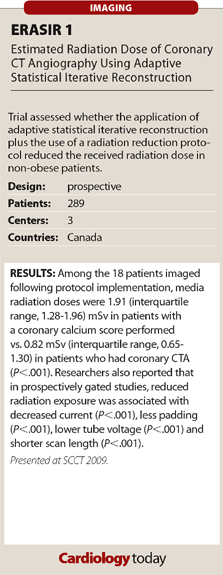ERASIR 1: Radiation reduction protocol implemented with ASIR can reduce radiation dose
Researchers hope for wider application of technologist-driven radiation reduction.
Society of Cardiovascular Computed Tomography 4th Annual Scientific Meeting
The implementation of radiation reduction protocols, coupled with the use of adaptive statistical iterative reconstruction, can reduce the radiation dose a patient receives without increasing image noise.
Researchers for the ERASIR 1 study enrolled 289 consecutive patients without obesity. All patients underwent 64-detector high definition coronary CTA, with 209 patients being studied prior to the implementation of protocol and 80 patients after the implementation of a radiation dose reduction protocol that included the use of 100 kV tubes, reduced current and minimized padding. The researchers also used adaptive statistical iterative reconstruction (ASIR), a reconstruction algorithm serving as an alternative to filtered back projection, for the reduction of image noise.
The researchers reported that among 18 patients imaged following protocol implementation, media radiation doses were 1.91 (interquartile range, 1.28-1.96) mSv in patients with a coronary calcium score performed vs. 0.82 (interquartile range, 0.65-1.30) mSv in the patients with coronary CTA performed (P<.001). They also reported that in prospectively gated studies, reduced radiation exposure was associated with decreased current (P<.001), less padding (P<.001), lower tube voltage (P<.001) and shorter scan length (P<.001).
“Implementation of stringent radiation reduction techniques including ASIR resulted in significant dose reduction in our consecutive, multicenter cohort,” Jonathan Leipsic, MD, a radiologist at Saint Paul’s Hospital in Vancouver, said in his presentation. “In spite of the extremely low radiation dose, image quality was preserved and signal-to-noise ratio was preserved or in fact approved. Perhaps, most importantly, a technologist-driven protocol can be put into place and we feel has real world applications that may be far-reaching in the ability to drive radiation doses lower in clinical practice.” – by Eric Raible

For more information:
- Leipsic J. Oral abstract 03. Presented at: Society of Cardiovascular Computed Tomography 4th Annual Scientific Meeting; July 16-19, 2009.
More news from the Society of Cardiovascular CT meeting -->
